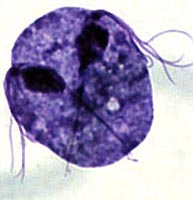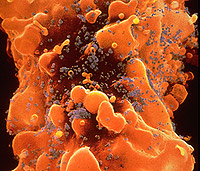Bacterial vaginosis is a violation of normal microflora (or, as it is also called doctors, dysbacteriosis) Vagina.
Content
What is bacterial vaginosis and gardnerellosis?
Narrum in the vagina lives a large number of lactic acid bacteria (Lactobacillus acidophilus,
They are also called lactobacteria and doderlyane chopsticks), which
Create a sour Wednesday. With bacterial vaginosis
Milk-acid bacteria decreases and come to their place
Pathological and so-called conditional pathogenic bacteria – Bacteria,
which cause disease only with reduced immunite. This is
Causes a decrease in the acidity of the medium in the vagina.
Previously thought that
Bacterial Vaginos is called mainly by some one type
Bacteria (for example, Gardnerners - Gardnerella Vaginalis or hemofilic chopsticks – Haemophilus vaginalis),
Therefore, bacterial vaginosis is still sometimes called hemophilic
or Gardnelese vaginitis. Now installed that bacterial
Vaginosis is not caused by some microbe, but a violation of the ratio
Different types of bacteria. Therefore, bacterial vaginosis is not
infectious disease and not transmitted during sexual contacts. IN
the difference from the vaginites (colpit) bacterial vaginosis does not cause
Inflammation in vagina.
How often is bacterial vaginosis?
Accurate
The frequency of bacterial vaginosis is not known. It is assumed that
bacterial vaginosis during life at least once sick each
Third woman.
Bacterial vaginosis are more often sick of women under the age of 35-40 years.
Basic risk factors for bacterial vaginosis

The main risk factors for bacterial vaginosis include:
- Availability
Intestinal dysbiosis. Intestinal dysbiosis and vagina often
develop at the same time. Can develop against the background of treatment
Antibiotics.
- Reducing immunity, but it is difficult to prove it.
- Reception of a large number of antibiotics. Antibiotics kill dairy and sour and others «Useful» Bacteria.
- Eranny food. Exception from the diet of milk-acidic products also increases the risk of dysbiosis.
- Wearing a dense not transmitting air linen, too frequent (up to daily) use of gaskets and tampons.
All this prevents the flow of oxygen into the vagina killing harmful anaerobic bacteria.
How bacterial vaginosis is manifested?
Basic
The manifestation of bacterial vaginosis is abundant (up to 20-30 ml in
Day) Serous Vaginal Selection. Isolation of rather liquid and
differ in the characteristic fish smell that amplifying after sexual
Act. Discomfort and burning during intercourse, or irritation of the vulva. Sometimes bacterial vaginosis may not cause any complaints.
How to diagnose bacterial vaginosis and gardnerellosis?
Bacterial
Vaginos is diagnosed by the presence of characteristic discharge from the vagina,
Reducing acidity and changes in the vaginal smear. Reduced
Acidity in the vagina is determined using the express method
(special indicator strips). This is affordable, reliable and inexpensive
diagnostic method, but, unfortunately, not very accurate.
Decisive
The value of the vaginal smear (cells of the cells with
Vagina walls) under a microscope. With bacterial vaginosis in a smear
There are practically no lactic acid bacteria (doderlyane sticks), but
Many other types of bacteria are defined (Gardnerlales, hemophilese),
as well as special «Key» Cells - Robed Vaginal Cells with
bacteria. Sometimes for a more subtle study
Selection vaginal microflors fall on special nutritious
Environments, which makes it possible to accurately determine the type of bacteria living in it.
Do I need to kill Gardnerner?
Bacterial
Vaginos need to be treated at least because without treatment he
accompanied by constant discharge from the vagina. In addition, it is
Condition can over time to go to a particular
inflammatory. The purpose of treatment is not
so many «Death Gardnerell», How much recovery required
Balance.
Long dysbacteriosis observed with bacterial
Vaginosis may disrupt the normal operation of the immune system.
Treatment of bacterial vaginosis and gardnerellosis
Treatment
Bacterial vaginosis consists of 2 stages: elimination of pathogens
and conditionally pathogenic bacteria (the same garardnell) and the population of the vagina
Normal lactobacteriums. To combat pathogens microbes
use vaginal candles and gels with different antibiotics or
antiseptics (for example, metronidazole or clindamycin). Selection
the right spectrum of action is difficult to do it yourself, and even more so without
Analyzes. Sometimes antibiotics are prescribed in tablets, according to the doctor's test.
Choosing specific
preparations and their dosage forms (tablets, candles, solutions, etc.)
Exercises a gynecologist, judging by the manifestations of the disease, state
Patients and results of analyzes. Faithful selection of therapy at this stage
Allows you to increase its efficiency, avoid side effects and
excess expenses. It should be remembered that not a separate infection is treated
(as, for example, chlamydia or candidiasis), and restores the balance
microflora, achieve what is much more difficult.
During pregnancy antibiotics are not used.
On the
The second stage of treatment may require drugs of lactobacilli inside
or directly in the vagina. Traditionally recommended a diet with
bioeffers, yogurts, sauerkraut. Sometimes in treating
Bacterial vaginosis use drugs that increase immunity.
However, the effect of many of these funds was not proved, and doctors
Guided, mainly by their own experience or tradition.
The feasibility of various methods for the treatment of intestinal dysbiosis in
Currently disputed.
Basic
criteria cure bacterial vaginosis and garcenellosis are
Termination of vaginal discharge and normalization of vaginal smear.









